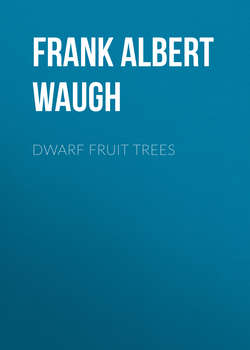Читать книгу Dwarf Fruit Trees - Frank Albert Waugh - Страница 6
III
PROPAGATION
ОглавлениеThe propagation of dwarf fruit trees is in some senses a more critical and interesting problem than the propagation of ordinary nursery stock. The successful production of a dwarf fruit tree depends primarily on its propagation. The selection of stocks for dwarfing purposes is necessarily a complicated matter. Under the terms of the problem it is impossible that the stock and the cion which are wedded together should be very closely related. The stock must be distinctly different and pronouncedly dwarfer in his habit of growth.
It is not always an easy matter to find a stock which is thus distinctly different from the tree which it is desired to grow and which will at the same time form with it a vigorous and long lived union. It is necessary further that the propagation can be carried on with ease and with a fair degree of success in commercial nurseries. If difficult methods of grafting are required, or if only a small stand of nursery trees can be secured, the undertaking becomes too expensive from the nurseryman's point of view.
The methods of propagating dwarf trees are for the most part the same as those used in reproducing the same kinds of fruit on standard stocks. As a matter of fact nearly all dwarf trees are propagated by budding. Apples, pears, and plums can be readily grafted, but budding is simpler, speedier, and usually the cheaper process in the nursery. In the upper Mississippi Valley, where plums are somewhat extensively worked on Americana plum roots, grafting is rather common. The side graft and the whip graft are the forms most used.
The theory of the production of a dwarf fruit tree by the restraining of its growth has already been mentioned in another chapter. The dwarf stock simply supplies less food than is required for the normal growth of the variety under propagation, and the tree is, in a sense, starved or stunted into its dwarf stature.
As the selection of proper stocks—the adaptation of stock to cion—is one of the fundamental problems in dwarf fruit growing, we may now address ourselves to that. We will take up the different classes of fruit in order.
THE APPLE
Everyone who has observed the wild or native apples which grow in New England pastures must frequently have noticed certain dwarf and slow-growing specimens. It it not difficult to find such which do not reach a height of five feet in ten years of unobstructed growth. If the cions of ordinary varieties of apples like Greening and Winesap should be grafted upon these stocks, the result would be a dwarf Greening or Winesap. If these dwarf wild apples could be produced with certainty and at a low price, they would furnish a source of supply for dwarf apple stocks.
The Paradise apple so-called (Fig. 7) is simply one of these dwarf varieties which can be reproduced freely and cheaply. This reproduction is secured nearly always by means of mound layerage. As the variety does not come true to seed, any more than such varieties as King or Hubbardston do, some such method of propagation is necessary. This Paradise apple is naturally inclined to stool out somewhat from the roots. This habit is encouraged by cutting the plants back to the ground. When the young shoots are thrown up they are banked up with a hoe or by plowing furrows up against the rows of plants. The young shoots then form roots at the base and these rooted shoots or layers are removed when one year old. They are then planted in nursery rows in the spring, where they are usually budded the following July or August.
These Paradise stocks are largely grown in France. Practically all the supply comes from that country. The nurserymen who grow dwarf apple trees in America import their stocks from France during the winter, plant them in nursery rows early in the spring, bud the stocks the following July or August, and have the dwarf apple trees for sale the second year following.
This Paradise is the dwarfest stock known for apples. Its effect on nearly all varieties is very marked, causing them to form very small trees and to bear very early. Some of the more vigorous varieties, like Northern Spy for instance, do not submit kindly to such treatment. For this, or possibly for more recondite reasons, a few varieties do not succeed well on Paradise roots. The writer would be glad to give a list of such varieties which are not adapted to the Paradise stock, but confesses he is unable to do so.
FIG. 7—PARADISE APPLE STOCKS IN EARLY SPRING
The Doucin stock is simply another variety of dwarf apple. It is more vigorous and larger growing than the Paradise, and, therefore, produces a tree, when ordinary varieties are grafted upon it, about midway in size between the ordinary standard apple and the same variety growing upon Paradise.
This Doucin is sometimes called the English or Broad-Leaved Paradise, but this name is misleading. It will be well to remember this in buying stocks or in buying trees in England. Dwarf apples are largely propagated in England, but the trees which are said to be on Paradise roots are often on Doucin. This confusion comes about from the Englishman's habit of calling Doucin the Broad-Leaved Paradise.
